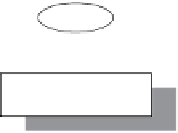Information Technology Reference
In-Depth Information
Rule Name: Male (X:Person) /* (X:Person) means the paramenter X
is a Person object */
IF (X::sex="Male") /* X::sex means the sex attribute value of
the object X */
Then true; /* The result of this rule is a boolean */
Rule Name: Child(X:Person, Y:Person) /* The parameters X and Y
are Person objects */
IF (X::father=Y) .OR. (X::mother=Y)
THEN true;
Rule Name: Son(X:Person, Y:Person)
IF Child(X,Y) .AND. Male(X)
THEN true;
Fig. 8.8
A family knowledge base
Male
Child
A
Son
heuristic
Fig. 8.9
The active generalization structure of the family knowledge base
Active generalization is similar to Heuristics. Heuristics can combine logical op-
erators (such as AND, OR, and NOT) to represent complex rules easily and clearly.
The AND and OR logical operators combine multiple active entities together in
active generalization. For example, the AND operator can combine the Child and
Male entities via the active generalization relationship to produce the Son entity.
Each active object is represented by a boolean value, i.e., true or false, in the frame
model metadata. If the rule in an active class fails to be triggered, the active object
will be false; otherwise, the active object will be true. The NOT entity allows nega-
tion, i.e., 'not false' is 'true'.
3. Coupling Generalization
The form of generalization between the coupling classes is the same as active gen-
eralization. Different coupling classes can use the generalization relationship to
combine to form a new coupling object. This hierarchical structure can represent
distributed knowledge (or distributed DB) semantics. For example: Consider two
databases, Person (in MS SQL Server) and Staff (in Oracle). The attributes for these
two databases are:




















Search WWH ::

Custom Search